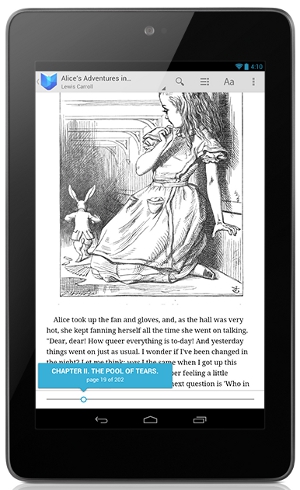Nexus 7 Tablet
My first ereaders were Palm Pilot handheld devices in the mid 1990s, on which I read such authors as Shakespeare and Mark Twain, despite their crude screens, the earliest of which was green, about 3″ x 4″.
So I was thrilled when I stumbled on the Sony 505 ereader at the Ann Arbor Borders Bookstore in 2007. I immediately recognized it as a significant upgrade in technology and a new home for my roughly thousand or more ebooks I had already downloaded from Gutenberg.org and elsewhere. Though I read many books and articles on it, the Sony 505 had lots of defects. It was slow, crashed a lot, and basically had no support from the manufacturer.
In May of 2011 I bought an Aluratech LIBRE Touch eBook Reader, with WiFi and a 7 inch TouchScreen. It was many generations of upgrading from the Sony 505, and I enjoyed it for a while, but then the fact that Aluratech never upgraded the software from Android 1.5 really degraded the experience. I plan to keep it, but it doesn’t handle PDFs efficiently enough, leading to frustrating delays and repetitions when resetting the size, requiring tedious moments of waiting while the processor crunches the numbers…. Still, the 7 inch screen and overall size and weight makes for very pleasant reading, especially of ePubs, which don’t have the problems of PDFs.
I held off buying a conventional tablet, such as the iPad, which to me is huge and clunky. I had had a Netbook for years, and the size of the various tablets were all too big to attract me. I felt I was duplicating what I already had, but without a keyboard.
Since I’ve had a Google Nexus S cellphone since late 2010, I immediately had an interest in the Nexus 7, upon good advice that it was coming out in late June. I bought one a few days after Google starting selling them online on June 27. Now that I’ve used Google’s Nexus 7 Tablet for nearly a month, I’m amazed at what an incredible advance it represents over the other ereaders I’ve had. It doesn’t matter to me that it doesn’t have a phone or camera capability. Of course, it’s more than an ereader, but that’s the primary purpose for which I bought one. That it has wireless and runs video exceptionally well are added advantages, as is its ability to handle email and surf the web. The enormous number of Android apps extend the device almost endlessly. The five built-in processors allow for instantaneous and efficient resizing of PDFs.
With the 16 gigabyte model, I copied my now roughly 5,000 ebooks and another 5,000 articles on to it with several gigabytes to spare, enough to probably more than double the number of books. A very seamless transition to a better and happier reading experience. The Android version is the current and most advanced, with free updates from Google, that support using the Kindle, Barnes and Noble, and the Kobo apps on it for expanded reading options, along with all the others. Google Books has built-in availability for many more millions of books.
For people with serious literary and cultural interests, Google’s Nexus 7 Tablet might be the one to consider if you have been holding off getting an ereading device.



